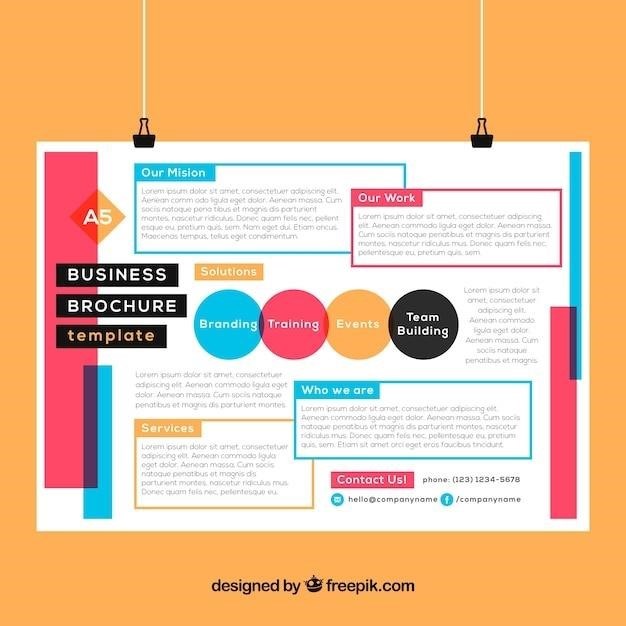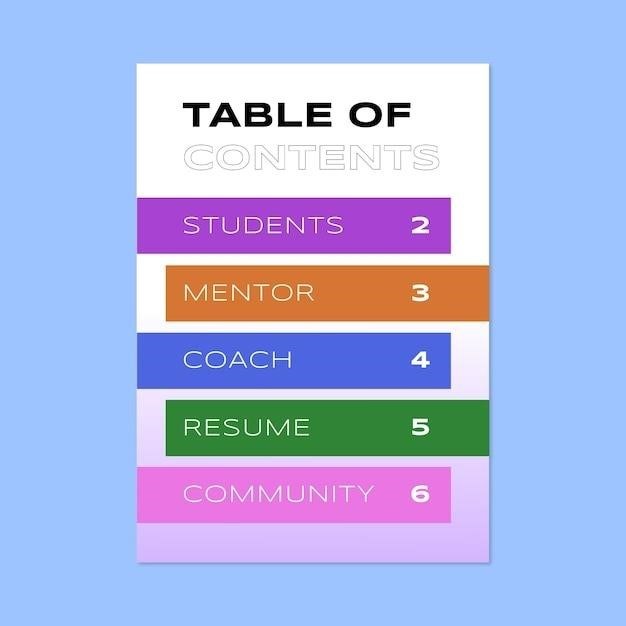

This cheat sheet provides a quick reference for core instructional design principles. It covers key models like ADDIE‚ Merrill’s Principles‚ and 4C/ID‚ emphasizing effective learning strategies and assessment methods. It also touches upon designing for diverse learning styles and leveraging technology for optimal learning outcomes. Remember to adapt these guidelines to your specific learning context and audience needs.
Introduction to Instructional Design
Instructional design (ID) is a systematic process of creating effective learning experiences. It’s a multi-faceted field encompassing various theories‚ models‚ and best practices to enhance teaching and learning. ID professionals analyze learning needs‚ define objectives‚ develop engaging content‚ and evaluate learning outcomes. This systematic approach ensures learners acquire knowledge and skills efficiently and effectively. The goal is to create impactful learning environments that cater to diverse learners and learning styles‚ optimizing knowledge retention and application. Instructional designers employ various methods such as lectures‚ workshops‚ e-learning modules‚ and simulations‚ adapting their approach based on the specific learning context and audience. They also incorporate feedback mechanisms to enhance the learning process continuously. Effective instructional design considers not only the content but also the learner’s experience‚ creating a holistic and engaging learning journey. The core principle is to make learning purposeful‚ relevant‚ and enjoyable for the learner. It’s a blend of art and science‚ requiring creativity and systematic planning for successful learning outcomes.
Key Instructional Design Models (ADDIE‚ Merrill’s Principles‚ 4C/ID)
Several prominent models guide the instructional design process. The ADDIE model (Analyze‚ Design‚ Develop‚ Implement‚ Evaluate) provides a linear‚ five-step framework. It begins with analyzing learning needs and objectives‚ followed by designing the instructional strategy‚ developing the learning materials‚ implementing the instruction‚ and finally‚ evaluating its effectiveness. Merrill’s Principles of Instruction offer a more task-centered approach‚ emphasizing the importance of learning tasks‚ relevant content‚ and practice opportunities. It prioritizes learners actively constructing knowledge through problem-solving and application. In contrast‚ the 4C/ID model (four-component instructional design) focuses on four essential components for complex learning⁚ learning tasks‚ supportive information‚ procedural information‚ and part-task practice. Each model offers a unique perspective‚ and the best choice often depends on the specific learning context and objectives. Understanding these models allows instructional designers to select the most appropriate framework for their projects‚ ensuring effective and efficient learning experiences. The key is to select and adapt the model that best suits the specific learning goals and context.
Bloom’s Taxonomy and Learning Objectives
Bloom’s Taxonomy provides a hierarchical framework for categorizing cognitive skills‚ crucial for defining clear learning objectives. It outlines six levels of cognitive complexity⁚ remembering‚ understanding‚ applying‚ analyzing‚ evaluating‚ and creating. When writing learning objectives‚ using action verbs aligned with these levels ensures clarity and precision. For instance‚ an objective at the “understanding” level might involve explaining a concept‚ while an “applying” level objective might require using the concept in a new situation. Objectives should be specific‚ measurable‚ achievable‚ relevant‚ and time-bound (SMART). This ensures that learning outcomes are clearly defined and easily assessed. By referencing Bloom’s Taxonomy‚ instructional designers can create learning experiences that target specific cognitive skills and promote deeper understanding. Well-defined‚ taxonomy-aligned objectives are essential for effective instruction and assessment‚ providing a roadmap for both the learner and the instructor.
Effective Learning Strategies and Activities
Effective learning hinges on employing diverse strategies catering to various learning styles and cognitive levels. Consider incorporating active learning techniques like group discussions‚ collaborative projects‚ and problem-solving exercises to enhance engagement and knowledge retention. Incorporate visual aids‚ real-world examples‚ and case studies to make learning more relatable and memorable. Gamification‚ incorporating game elements into learning activities‚ can boost motivation and participation. Encourage spaced repetition and retrieval practice‚ techniques proven to improve long-term memory. Provide opportunities for learners to apply their knowledge through simulations‚ role-playing‚ or practical applications. Regular feedback and formative assessments offer valuable insights into learner progress‚ allowing for adjustments to the instructional approach. Remember to vary activities to maintain learner interest and cater to different learning preferences. A balanced approach‚ combining diverse strategies‚ optimizes learning outcomes.
Designing for Different Learning Styles
Effective instructional design acknowledges the diversity of learning styles. Visual learners benefit from diagrams‚ charts‚ and videos; auditory learners thrive with lectures‚ discussions‚ and audio recordings; kinesthetic learners excel with hands-on activities‚ simulations‚ and role-playing. Incorporate a variety of learning modalities to cater to these diverse preferences. Provide multiple pathways to access information‚ allowing learners to choose methods that suit their strengths. For example‚ offer both written and video explanations of concepts. Use a mix of media‚ including text‚ images‚ audio‚ and video‚ to create a rich and engaging learning experience. Consider providing options for individual and group work‚ allowing learners to choose their preferred collaboration style. Remember‚ designing for diverse learning styles enhances accessibility and promotes inclusivity‚ leading to better learning outcomes for all participants.
Creating Engaging Learning Experiences
Engaging learners is crucial for effective instruction. Incorporate interactive elements like games‚ simulations‚ and quizzes to actively involve learners in the learning process. Use storytelling and real-world examples to make the content relatable and relevant. Design activities that encourage collaboration and peer-to-peer learning. Provide opportunities for learners to apply their knowledge through practical exercises and projects. Incorporate multimedia elements‚ such as videos‚ animations‚ and interactive infographics‚ to enhance visual appeal and engagement. Break down complex information into smaller‚ manageable chunks to prevent cognitive overload. Use clear‚ concise language and avoid jargon. Provide regular feedback and opportunities for learners to self-assess their understanding. Consider incorporating gamification elements‚ such as points‚ badges‚ and leaderboards‚ to motivate learners and foster a sense of accomplishment. Remember‚ creating an engaging learning experience makes learning more enjoyable and effective.
Assessment and Evaluation Methods
Effective assessment is vital for measuring learning outcomes. Employ a variety of assessment methods to cater to different learning styles and measure diverse skills. Use formative assessments‚ such as quizzes and short assignments‚ to monitor learning progress throughout the course. Summative assessments‚ like exams and final projects‚ evaluate overall learning achievement. Consider using authentic assessments‚ such as case studies and simulations‚ to assess real-world application of knowledge. Provide clear rubrics and feedback to learners‚ explaining assessment criteria and guiding improvement. Utilize both quantitative and qualitative data to gain a comprehensive understanding of learner performance. Quantitative data‚ like test scores‚ provide objective measures‚ while qualitative data‚ such as feedback and observations‚ offer insights into learner understanding and engagement. Ensure assessments align with learning objectives and accurately reflect the knowledge and skills taught. Regularly review and refine assessment methods based on learner feedback and performance data to optimize their effectiveness and ensure they accurately measure intended learning outcomes. Remember that assessment is not merely about grading; it’s a tool for improving learning.
Utilizing Technology in Instruction
Technology enhances instruction by providing engaging and interactive learning experiences. Learning Management Systems (LMS) like Moodle or Canvas facilitate course management‚ communication‚ and assessment delivery. Multimedia resources‚ including videos‚ simulations‚ and interactive exercises‚ cater to diverse learning preferences and boost engagement. Educational apps and software offer targeted practice and personalized feedback‚ adapting to individual learner needs. Webinars and virtual classrooms foster real-time interaction and collaboration‚ breaking down geographical barriers. Remember to consider accessibility when selecting and implementing technology. Ensure materials are compatible with assistive technologies and adhere to accessibility guidelines. Provide learners with adequate technological support and training to prevent frustration and maximize the benefits of technology integration. Regularly evaluate the effectiveness of technology integration‚ gathering feedback from learners on their experience and adjusting your approach as needed. Prioritize user-friendly interfaces and intuitive design to ensure easy navigation and efficient learning. Balance technology use with traditional methods to maintain a rich and holistic learning environment‚ avoiding over-reliance on any single approach.
Instructional Design Templates and Cheat Sheets
Templates and cheat sheets streamline the instructional design process‚ providing pre-formatted structures and helpful reminders. Utilizing these tools ensures consistency and efficiency‚ particularly beneficial for large-scale projects or when working with multiple designers. Templates for lesson plans‚ course outlines‚ and assessment rubrics offer standardized formats for organizing content and objectives. Cheat sheets for writing learning objectives‚ crafting effective assessments‚ and designing engaging activities serve as quick references for best practices. These resources are particularly valuable for novice instructional designers‚ providing guidance and support. However‚ experienced designers also benefit from templates and cheat sheets‚ leveraging them to maintain quality and ensure adherence to established standards. Remember to adapt templates to suit specific needs‚ avoiding a rigid adherence that might stifle creativity or fail to address unique learning contexts. Consider developing customized templates and cheat sheets‚ drawing on personal experiences and preferences to further optimize workflow. Sharing and collaborating on templates within teams fosters consistency and promotes a shared understanding of design principles. Regularly review and update templates and cheat sheets to reflect best practices and evolving design strategies.
Best Practices for Online Course Design
Effective online course design prioritizes learner engagement and accessibility. Structure content logically‚ using clear headings‚ concise paragraphs‚ and multimedia elements to break up text. Incorporate interactive activities‚ such as quizzes‚ discussions‚ and simulations‚ to enhance knowledge retention and active learning. Provide regular feedback and opportunities for interaction to foster a sense of community and support. Design for diverse learning styles‚ offering varied content formats and delivery methods to cater to individual preferences. Ensure accessibility by using appropriate font sizes‚ color contrasts‚ and alternative text for images. Regularly evaluate the course‚ seeking student feedback and adapting the design based on their responses. Optimize the course for different devices and browsers to ensure seamless access across platforms. Use learning management systems (LMS) effectively to manage assignments‚ grades‚ and communication. Prioritize clear navigation and intuitive design‚ making it easy for students to find information and complete tasks. Remember that effective online courses balance structured content with engaging activities‚ fostering both knowledge acquisition and learner satisfaction. Continuously update the course content to ensure relevance and accuracy‚ reflecting current best practices in the field.
Resources and Further Learning
To deepen your understanding of instructional design‚ explore reputable online resources and professional organizations. Websites like the Association for Educational Communications and Technology (AECT) and the International Society for Technology in Education (ISTE) offer valuable insights‚ research papers‚ and best practices. Consider enrolling in online courses or workshops focused on instructional design methodologies‚ learning technologies‚ and assessment strategies. Numerous universities and online learning platforms provide comprehensive programs covering various aspects of instructional design‚ from theoretical foundations to practical application. Stay updated on current trends and research by subscribing to relevant journals and newsletters in the field of education technology. Engage with online communities and forums dedicated to instructional design to share experiences‚ seek advice‚ and learn from peers. Explore freely available online resources‚ such as instructional design templates‚ sample course materials‚ and case studies‚ to gain practical experience. Remember that continuous learning and professional development are crucial for staying abreast of the ever-evolving landscape of instructional design. By actively engaging with these resources‚ you can enhance your skills and contribute to creating impactful and effective learning experiences.
